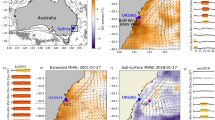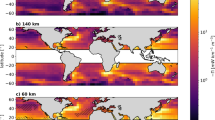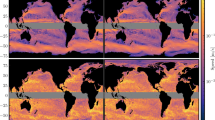Abstract
Surface waves play an important role in the exchange of mass, momentum and energy between the atmosphere and the ocean. The development of the wave field depends on wind, wave–wave and wave–current interactions and wave dissipation owing to breaking, which is accompanied by momentum fluxes from waves to currents. Wave breaking supports air–sea fluxes of heat and gas1,2, which have a profound effect on weather and climate. But wave breaking is poorly quantified and understood. Here we present measurements of wave breaking, using aerial imaging and analysis, and provide a statistical description of related sea-surface processes. We find that the distribution of the length of breaking fronts per unit area of sea surface is proportional to the cube of the wind speed and that, within the measured range of the speed of the wave fronts, the length of breaking fronts per unit area is an exponential function of the speed of the front. We also find that the fraction of the ocean surface mixed by breaking waves, which is important for air–sea exchange, is dominated by wave breaking at low velocities and short wavelengths.
This is a preview of subscription content, access via your institution
Access options
Subscribe to this journal
Receive 51 print issues and online access
$199.00 per year
only $3.90 per issue
Buy this article
- Purchase on Springer Link
- Instant access to full article PDF
Prices may be subject to local taxes which are calculated during checkout




Similar content being viewed by others
References
Melville, W. K. The role of surface wave breaking in air-sea interaction. Annu. Rev. Fluid Mech. 28, 279–321 (1996).
Jessup, A. T., Zappa, C J., Loewen, M. R. & Heasy, V. Infrared remote sensing of breaking waves. Nature 385, 52–55 (1997).
Phillips, O. M. Spectral and statistical properties of the equilibrium range in wind-generated gravity waves. J. Fluid Mech. 156, 505–531 (1985).
Duncan, J. H. An experimental investigation of breaking waves produced by a towed hydrofoil. Proc. R. Soc. Lond. A 377, 331–348 (1981).
Melville, W. K. Energy dissipation by breaking waves. J. Phys. Oceanogr. 24, 2041–2049 (1994).
Rapp, R. J. & Melville, W. K. Laboratory measurements of deep-water breaking waves. Phil. Trans. R. Soc. Lond. A 331, 735–800 (1990).
Melville, W. K. & Rapp, R. J. Momentum flux in breaking waves. Nature 317, 514–516 (1985).
Loewen, M. A. & Melville, W. K. Microwave backscatter and acoustic radiation from breaking waves. J. Fluid Mech. 224, 601–623 (1991).
Phillips, O. M., Posner, F. L. & Hansen, J. P. High range resolution radar measurements of the speed distribution of breaking events in wind-generated ocean waves: Surface impulse and wave energy dissipation rates. J. Phys. Oceanogr. 31, 450–460 (2001).
Monahan, E. C. & Muircheartaich, I. Optimal power-law description of oceanic whitecap coverage dependence on wind speed. J. Phys. Oceanogr. 10, 2094–2099 (1980).
Wu, J. Variations of whitecap coverage with wind stress and water temperature. J. Phys. Oceanogr. 18, 1448–1453 (1988).
Donelan, M. A., Longuet-Higgins, M. S. & Turner, S. Periodicity in whitecaps. Nature 239, 449–451 (1972).
Lamarre, E. & Melville, W. K. Air entrainment and dissipation in breaking waves. Nature 351, 469–451 (1991).
Lamarre, E. & Melville, W. K. Void-fraction measurements and sound speed fields in bubble plumes generated by breaking waves. J. Acoust. Soc. Am. 95, 1317–1328 (1994).
Willert, C. & Gharib, M. Digital particle image velocimetry. Exp. Fluids 10, 181–193 (1991).
Hara, T. & Belcher, S. E. Wind forcing in the equilibrium range of wind-wave spectra. J. Fluid Mech. (submitted).
Phillips, O. M. The Dynamics of the Upper Ocean (Cambridge Univ. Press, Cambridge, 1977).
Banner, M. L., Jones, I. S. F. & Trinder, J. C. Wavenumber spectra of short gravity waves. J. Fluid Mech. 198, 321–344 (1989).
Jähne, B. K. & Riemer, K. S. Two-dimensional wavenumber spectra of smallscale water surface waves. J. Geophys. Res. 95, 11531–11546 (1990).
Fedorov, A. V., Melville, W. K. & Rozenberg, A. An experimental and numerical study of parasitic capillary waves. Phys. Fluids 10, 1315–1323 (1998).
Andreas, E. L. A new sea spray generation function for wind speeds up to 32 m s- 1. J. Phys. Oceanogr. 28, 2175–2184 (1998).
Terrill, E. J., Melville, W. K. & Stramski, D. Bubble entrainment by breaking waves and their influence on optical scattering in the upper ocean. J. Geophys. Res. 106 (C8), 16815–16824 (2001).
Madsen, O. S., Poon, Y.-K. & Graber, H. C. in Coastal Engineering 1988, Proc. 21st Int. Conf. Coastal Eng. (ed. Edge, W. L.) 492–504 (American Society of Civil Engineers, New York, 1989).
Ardhuin, F., Herbers, T. H. C & O'Reilly, W. C. A hybrid Eulerian-Lagrangian model for spectral wave evolution with application to bottom friction on the continental shelf. J. Phys. Oceanogr. 31, 1498–1516 (2001).
Acknowledgements
These measurements would not have been possible without the fearless flying of T. Crawford and the support of his group at NOAA who made additional airborne measurements. We are grateful to D. Shear for his work on the initial design, construction and testing of the aerial imaging system. W.K.M. thanks T. Hara and O. Phillips for stimulating conversations on the measurement and modelling of equilibrium wave spectra, and O. Madsen and T. Herbers for advice on wave dissipation in bottom boundary layers. We are grateful to F. Veron for carefully reading and commenting on the manuscript. W.K.M. acknowledges the hospitality of the Isaac Newton Institute, Cambridge University, during the revision of this paper. This work was supported by grants from the ONR (Physical Oceanography) and the NSF (Ocean Sciences).
Author information
Authors and Affiliations
Corresponding author
Rights and permissions
About this article
Cite this article
Melville, W., Matusov, P. Distribution of breaking waves at the ocean surface. Nature 417, 58–63 (2002). https://doi.org/10.1038/417058a
Received:
Accepted:
Issue Date:
DOI: https://doi.org/10.1038/417058a
This article is cited by
-
Particle motions beneath irrotational water waves
Ocean Dynamics (2015)
-
Determining the onset and strength of unforced wave breaking in a numerical wave tank
China Ocean Engineering (2014)
-
Energy dissipation through wind-generated breaking waves
Chinese Journal of Oceanology and Limnology (2012)
-
Impact of Ocean Spray on the Dynamics of the Marine Atmospheric Boundary Layer
Boundary-Layer Meteorology (2011)
Comments
By submitting a comment you agree to abide by our Terms and Community Guidelines. If you find something abusive or that does not comply with our terms or guidelines please flag it as inappropriate.



